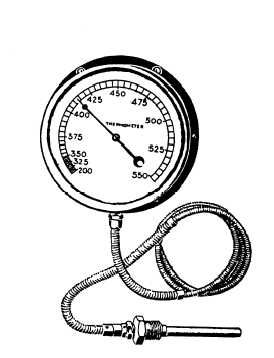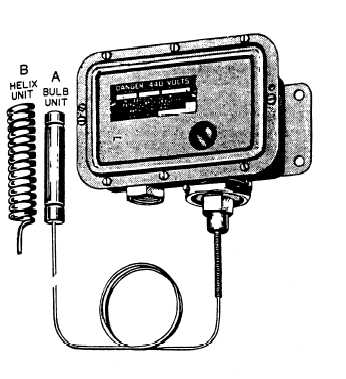as long as 125 feet, which separates the sensing
bulb from the Bourdon tube and dial (fig. 8-14).
There are three basic types of distant-reading
thermometers: the liquid filled, the gas filled,
and the combination liquid-vapor filled. The
thermometers are filled with fluid (liquid or gas)
at some temperature and sealed. Almost the entire
volume of the fluid is in the sensing bulb.
As the temperature of the bulb changes, the
volume of the fluid tries to change. Since
the volume of the thermometer (sensing bulb,
capillary, and Bourdon tube) is constant, a
pressure change occurs within the thermometer.
This pressure change causes the Bourdon tube to
straighten out (with an increase in pressure),
working a system of levers and gears, which causes
the thermometer pointer to move over the dial and
register temperature.
TEMPERATURE SWITCHES
Temperature switches operate from tempera-
ture changes occurring in an enclosure, or in the
air surrounding the temperature-sensing element.
The operation of the temperature switch is similar
to the operation of the pressure switch shown in
figure 8-9; both switches are operated by changes
in pressure. The temperature element is arranged
so a change in temperature causes a change in the
internal pressure of a sealed-gas or air-filled bulb
Figure 8-14.—Distant-reading, Bourdon-tube thermometers.
or helix, which is connected to the actuating device
by a small tube or pipe. Figure 8-15 shows a
temperature switch and two types of sensing
elements.
A temperature change causes a change in the
volume of the sealed-in gas, which causes
movement of a bellows. The movement is
transmitted by a plunger to the switch arm. The
moving contact is on the arm. A fixed contact may
be arranged so the switch will open or close on
a temperature rise. This allows the switch contacts
to be arranged to close when the temperature
drops to a predetermined value and to open when
the temperature rises to the desired value. The
reverse action can be obtained by a change in the
contact positions.
GAUGE SNUBBERS
The irregularity of impulses applied to the
fluid power system by some pumps or air
compressors causes the gauge pointer to oscillate
violently. This makes reading of the gauge not
only difficult but often impossible. Pressure
oscillations and other sudden pressure changes
existing in fluid power systems will also affect the
delicate internal mechanism of gauges and cause
either damage to or complete destruction of the
Figure 8-15.—Temperature switch with two types of sensing
elements. A. Bulb unit. B. Helix unit.
8-8



